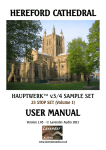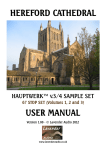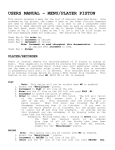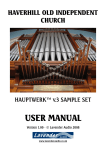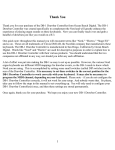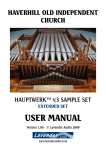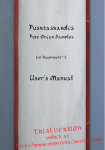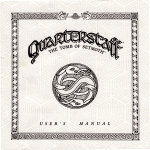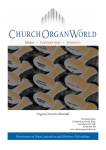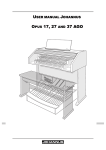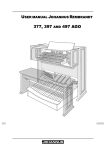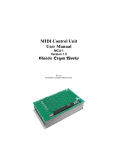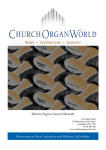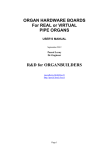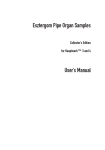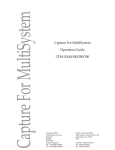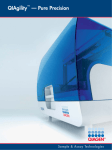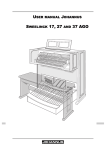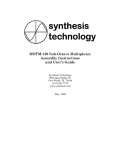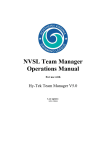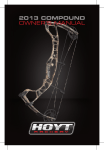Download User Manual - Lavender Audio
Transcript
HEREFORD CATHEDRAL HAUPTWERK™ v.3/4 SAMPLE SET 46 STOP SET (Volume 2) USER MANUAL Version 1.05 - © Lavender Audio 2011 www.lavenderaudio.co.uk HEREFORD CATHEDRAL HAUPTWERK™ v.3/4 SAMPLE SET USER MANUAL Thank you for purchasing this sample set. Please take a little time to read this manual to familiarise yourself with the various features it offers. NB. Hauptwerk versions 3 (version 3.23 minimum) and 4 are both supported. 1. Installation To be able to load the Hereford 46 stop sample set, both volume 1 and volume 2 in the Hereford Cathedral organ series need to be installed. If you haven't already, install volume 1 by using Hauptwerk's component installer to ensure proper installation and configuration of this sample set. Start Hauptwerk and (unless installing from a download) insert DVD1 into your DVD drive. In Hauptwerk, choose File | Install organ, sample set, temperament or impulse response ... and then navigate to your DVD drive or to the location you saved the downloaded installation files and find the first data installation package (it's called HerefordCathedral-DataPackage1). Once Hauptwerk has analysed the package you will be presented with the sample set licence which you will need to accept. After a while, the following screen is presented. Ensure that the Selected installation action for the [Data] item is set to Install and then click OK. Installation should then proceed and the whole process should complete quickly. Once you have finished with DVD1, remove it and insert DVD2 into your DVD drive. Repeat the process described above, installing HerefordCathedral-DataPackage2. Optionally at this point, you may choose to install the Hereford 23 Stop Organ – this is an instrument that only requires the Volume 1 data components to function and the component package for this is also found on DVD2. Note that there is only one version of this file, suitable for both Hauptwerk versions 3 and 4. Now you need to repeat this process several times to install all of the Volume 2 components, specifically: HerefordCathedral-DataPackage3 (on DVD3, the first DVD of the volume 2 set) HerefordCathedral-DataPackage4 (on DVD4, the second DVD of the volume 2 set) Hereford-46-Stop-Organ (also on DVD4, choosing either the Hauptwerk version 3 or version 4 component package) Assuming this is all successful, the organ is now ready to load for the first time. Further information relating to this can be found in section 3. NB. Use of this sample set requires an update to your Hauptwerk dongle. You should have received this update by the time the DVD has arrived. If not, please contact Lavender Audio. Note also that if you have already installed the Evaluation set, you will not need to install the contents of DVD1 (ie Data Package 1). 2. Specifications and background information The majority of great Continental European organs occupy the ideal position high on the west wall. The position is ideal not just from a sound projection basis, but also from a sampling perspective, where most (if not all) divisions of the organ are often able to be captured by microphones placed at a suitable “sweet spot”. In the UK with its great choral tradition, the church and Cathedral organ is first and foremost an instrument to accompany a choir which is usually situated to the east. This results in organs that are sometimes buried in chambers and spread out in a variety of locations, with some parts of the organ sounding more clearly than others. This is very much the situation that Hereford finds itself in and provides something of a dilemma for the sampling engineer. Microphones placed to the west of the organ in the nave would probably result in the best balance and blend and this tends to be the favoured position for CD recordings. However, this balance is at the expense of the detail of faster playing as the generous acoustic of the Cathedral rather takes over, leading to a loss of definition. There's also the issue of some divisions sounding very distant. Therefore, the decision was taken to use a multi-mic recording setup in the Quire and organ console area, which results in a sound that is close to that experienced by the organist in his/her elevated position directly opposite the pipes. Multiple releases were recorded, which add greatly to the realism of the sample set. All pipes have a release recorded for both staccato and sustained notes and the vast majority of pipes have a third set of releases for notes held for a duration between staccato and sustained (portato - typically 200 to 500 mS, depending on pitch). Incidentally, multiple releases are handled automatically by Hauptwerk and no special hardware or configuration is necessary. Each sample was sustained for an average of 6 seconds and each has been programmed to have either 3 or 4 loops. Having more than one loop imparts some life to the sound and makes long sustained notes sound more realistic. Separate tremulant samples are provided for the Viola da Gamba, Cor Anglais and Orchestral Oboe, which are all stops on the Solo. These provide for greater realism than is possible by using Hauptwerk's tremulant model, albeit with a lack of synchronisation between the samples. In practice, this is not as noticeable as might be anticipated and the extra “tremmed” long releases more than make up for this compromise. When switching the tremulant on or off, the “tremmed” and “non-tremmed” samples are cross-faded, to give a more realistic feel of the tremulant starting and stopping. This avoids the somewhat unnatural sound of the sample attack being retriggered as the tremulant is switched on or off whilst the note is being held. For other Solo and low pressure Swell stops, a range of tremulant samples were taken and these were processed using a special tool kindly provided by the creators of Hauptwerk. The Hauptwerk tremulant model has been carefully programmed to provide for maximum realism within the constraints of the model. Likewise a large number of Solo and Swell samples were analysed for the level and harmonic differences between the swell box being open and shut and the results of this used to programme accurately Hauptwerk's swell models. Both the tremulant and swell parameters can be further adjusted by using the voicing tools (Advanced edition only). The Swell Vox Angelica is an undulating stop which beats with the Salicional. When the Vox Angelica drawstop is drawn, the Salicional rank automatically sounds as well, meaning that this stop does not also need to be drawn to obtain the celeste effect. This behaviour is exactly as is found on the real instrument and means that it was not possible to sample just the detuned rank on its own - the Vox Angelica samples inevitably include those of the Salicional in addition. Therefore, a mechanism has been provided within the organ definition which automatically silences the Salicional samples when the Vox Angelica is drawn. To achieve this, cross-fading has again been used which gives a more realistic effect than simply switching samples (which could result in inappropriate attack transients being heard when holding chords and changing registration). Even so, the effect is not perfect and sounds best when stop action delay is enabled. The Solo Viola da Gamba/Voix Celeste situation is similar, although programming complexities mean that currently samples are switched rather than cross-faded. The organ is tuned to equal temperament at approximately A=440 Hz. At the time of sampling, the organ was well tuned, so all of the samples have been left at their recorded pitch with only the most out of tune being repitched from within the organ definition file. As a result, the normal tuning errors that are found in even the best regulated organs are present here and therefore contribute to the overall realism of the organ. However, it may be considered necessary to use the organ at either a different pitch or with a different temperament. This is possible and the organ definition file has been carefully programmed to produce appropriate randomised tuning errors when not using the original organ tuning (the strength of these tuning errors can be adjusted within Hauptwerk or even disabled completely). The most realistic sound, though, will be when the original organ tuning is selected. Note that adjusting the random tuning errors has no effect in original organ tuning mode. 3. System requirements and loading the organ for the first time With 46 stops and 3 separate tremulants speaking into a fairly large acoustic, computer processor and memory requirements are moderate by today's computing standards. A sensible minimum of a 64 bit operating system, 8GB RAM and a good dual core processor is suggested, although acceptable results may well be obtained with more modest resources, depending on the loading configuration. Bear in mind that only 2/3 system memory is accessible on Mac OSX, whereas Windows 7 typically allows all free memory to be used (for a rough rule of thumb for the amount of free memory with Hauptwerk running but with no organ loaded, subtract 1.5 GB from the total installed memory if your Windows installation is relatively clean). The sample set was developed on a PC consisting of an Intel Core 2 Quad Q6600 processor with 12 GB of system memory running Windows 7 64 bit and this platform has proven more than adequate to run this organ with all realism features enabled. The following table gives very approximate figures for the amount of RAM (memory) the organ requires with various different loading options set. None of these figures take into account the RAM needed by the operating system or Hauptwerk itself. Where no figure is given, that particular loading option (although valid) hasn't been tested, generally because it wouldn't make sense to use it. Of course, not all ranks need to have the same settings. Given the memory requirements shown below, to avoid significant compromise, Hauptwerk Advanced Edition should be considered essential. To achieve best results, the organ should be loaded at 24 bits resolution, no memory compression and with all realism features enabled. If your system doesn't have sufficient memory to allow this, then it is recommended to try the following in order until the set loads reliably (it is wise to allow for a small amount of unused memory to keep the operating system happy !) ¨ Use lossless memory compression (audio quality is unaffected although polyphony is reduced by approximately 15%) ¨ Load some or all samples at 20 bit resolution ¨ Load some or all samples at 16 bit resolution. ¨ Only load a single loop on some or all samples. ¨ Load some or all samples at 14 bit resolution ¨ Only load single releases for some or all samples It is possible to go a fair way down this list with little obvious loss of realism or quality – however the last two options should both be avoided if at all possible. You can also reduce the load on your computer's processor by disabling the wind model (not appropriate in the US), disabling real time harmonic shaping and disabling interpolation, all of which will affect the realism of the organ. The first time the organ is loaded the sample cache is built. This takes a considerable time – maybe 5 minutes or more. However, subsequent loads are much quicker. Once the organ is loaded, you can use Hauptwerk to connect the keyboards, stops, pistons and swell pedals of your MIDI setup as necessary. Before doing so, it may be worth reading the following section which contains useful information on the various playing aids incorporated in this organ as well as offering suggestions on how best to connect more modestly equipped consoles. 4. Hereford Cathedral Sample Set Screens With the advent of Hauptwerk version 4 and its ability to resize organ display screens, the display elements of the Hereford organ definition file are built around a standard monitor resolution of 1280 x 1024 pixels. For those still using HW v3, this display resolution is therefore a minimum system requirement. Assuming the use of HW v4 and a 1280 x 1024 monitor, best results will be obtained by choosing not to zoom the display and operating in full screen mode where everything fits nicely. However, graphics quality with Hauptwerk zooming enabled is still very high, so other screen resolutions or window sizings will still give excellent results. Console Screen This view offers the most realistic view of the organ, with stops, keys, couplers, combination pistons and swell pedals all responding to the mouse as well, of course, to MIDI input signals. Much of what is displayed on this screen will be self-explanatory, but the basic description which follows may prove to be useful. The order of the manuals, from top to bottom, is Solo, Swell, Great and Choir. Each manual has eight combination pistons which are located immediately below on the keyslip. The row of pistons above the Solo manual are general combinations, which act on every stop and coupler on the organ. For the divisionals, any piston labeled with a 0 will cancel all stops on that division – as might be expected, General 0 is effectively a general cancel. The pedal organ also has a total of eight combination toe pistons, which are located to the right of the swell pedals. The effect of the Great and Pedal pistons may be combined by drawing the “Gt & Ped Combs Coupled” coupler, whereby pressing a Great divisional piston will cause the corresponding Pedal combination to act as well (and vice versa when pressing a pedal toe piston). The row of toe pistons to the left of the swell pedals are, by default, a duplication of the swell divisionals; however, the “Gens. On Sw. Toe Pistons” transfer, when enabled, will change their use to being a duplication of the General pistons. This is of limited use when controlling the organ purely via touchscreen, but potentially very handy for those with fully equipped consoles. Finally all pistons may be set by clicking on the latching button labeled “L” and then pressing the desired piston once the desired combination of stops and/or couplers have been drawn. Don’t forget to press “L” again to disable capture, once piston setting is complete. The extensive selection of couplers should be largely self-explanatory. Willis was not entirely consistent with couplers “coupling through” .... for example, drawing Solo to Great and Great to Pedal will result in the Solo being heard on the Pedal. However, if Solo to Swell and Swell to Great are drawn, the Solo is not heard on the Great. An exception to this latter rule is Great to Solo, where all manuals coupled to the Great at all pitches will also sound on the Solo. Experimentation with the couplers is probably the best way to further understanding ! The “Doubles Off” control mutes the manual and pedal doubles (ie manual 16s and pedal 32s). It also mutes any Solo 16s (see below for details of this) as well as disabling the action of any suboctave coupler. Note that when activating Doubles Off, the affected stops and couplers do not visibly change state. The Solo organ 16 foot controls need a little explanation. Both the Orchestral Oboe (on low pressure) and Tromba (high pressure) have an extra octave of pipes at 16 foot pitch. These are accessed by pressing the associated control labeled “16”. In the case of the Tromba, this effectively turns the rank into a 16 foot stop. Whilst the same is true for the Orchestral Oboe when its 16 foot control is activated, all of the other low wind pressure stops (Viola da Gamba, Harmonic Flute, Cor Anglais etc) are also dropped in pitch by an octave. As these other stops don't have any extra pipes, the bottom octave will have no sound with the low pressure 16 foot control activated. Stops + Pistons Screen This screen is probably of most use to those who will be controlling the Hereford organ with a single screen. The appearance and functionality of the stops and couplers is identical to that of the previous screen – however, there is a third row of couplers which are provided as playing aids for those who have more modest console setups. Basscouplers offer a way of playing the pedal organ from the manuals. This can be useful in various circumstances, not least if your virtual organ lacks a pedalboard ! The basscoupler is intelligent in that only the lowest manual note sounds on the pedal, meaning that only one note is played at a time, giving a far more musical result than a simple “Pedal to Manual” coupler. For those with consoles having less than four manuals, Hauptwerk offers a very powerful way of accessing all four divisions of the Hereford organ by using “Floating Keyboards” (in HW v3 these were called “Redirectible Keyboards”). Once set up, one or more physical keyboards can easily be routed to any of the Hereford divisions, either by using a MIDI organ control, keyboard shortcut or an on screen piston control (HW v4 only). This functionality is native to Hauptwerk, so the HW user guide should be consulted for further details. In contrast, however, Hauptwerk doesn't provide any easy way of flexibly sharing a single expression pedal. As this organ has two enclosed divisions, ideally two physical expression pedals would be used for maximum control. For those whose consoles have just one expression pedal, the concept of a floating swell pedal has been introduced. An additional (non-visible) expression pedal called “Floating Swell Pedal” has been provided for mapping to a single console expression pedal – this can then be routed to the Swell and/or the Solo by using the appropriate tab control. Note that at the point at which the console expression pedal is routed to either Swell or Solo, the pedal being controlled will abruptly move to the position of the console MIDI pedal. An indicator showing the status of each virtual expression pedal has been provided to help avoid any excessive discrepancies. For those with two expression pedals, it is still possible to map directly to the Swell and Solo pedals separately in the usual way. On this screen, there is space to include the full complement of pistons and reversibles. In addition to those described previously, there are two settable pistons that control just the couplers, as well as an all coupler cancel and a piston to cancel all octave and unison off couplers. Reversible pistons act on just one coupler, with each press of the piston toggling the position of the associated coupler. Again, these are of most use when mapped to a physical console MIDI control. LH and RH Jambs These screens display the stops over two pages and are useful if you have a multi-monitor setup. The layout of the stops doesn't exactly conform to the real instrument, but is approximately correct, albeit with the couplers now presented as drawstops rather than rocking tabs. These two pages support intelligent re-sizing (HW v4 only), which allows screens rotated to a portrait position to be used more effectively. The stops and couplers in each screen are all linked, so that if you operate a particular stop in (for example) the Console screen, its counterpart in the Stops + Pistons and appropriate Jamb screen will also change. Settings Screen This screen allows configuration of some of the specific features that contribute to the overall realism of the organ. The blower noise, tremulant noise and swell shade noise can all be switched on or off and the relative volume of each can be adjusted. In addition, the noise of the stop action can be set for each division individually, as can the key action noise for Great, Swell and Choir (the key action noise for the Solo and Pedal was found to be virtually inaudible on the original instrument, hence that option is not available here). Note that for some samples, especially on the Swell and Great, the note action on the Hereford organ is relatively noisy and it wasn't possible to totally remove this sound without adversely compromising the quality of the samples. Therefore, even with the key action noise disabled, some residual action noise may be noticed. For many large instruments with detached consoles there is a small but noticeable delay in the operation of the stop action. This is particularly evident when using combination pistons where organists are used to having to anticipate such a delay, meaning that having a stop sound as soon as the piston has been pressed will feel unnatural. With the Stop Action Delay enabled, a small delay between the stop being pulled (either via your console's stop control mechanism or via the combination pistons) and the rank starting to sound will be noticed. Note that the stop action noise still sounds straight away, with the rank sounding approximately at the point at which the action noise starts to decay. Again, this stop action delay facility can be enabled or disabled on a per division basis. The final setting is for the Trumpet stop on the Solo organ, which is a separate appearance of the Great Trumpet. If the Separate Rank is enabled and the appropriate samples loaded into memory, then this stop on the Solo organ may be voiced without affecting the same stop on the Great. For quick and easy adjustments, a volume and a tone slider are provided, but the Hauptwerk voicng tools (Advanced edition only) are recommended for best results. The separate rank facility is particularly useful to voice up the Trumpet so that, in conjunction with the Tromba, a passable Tuba may be created. If the separate rank is not enabled, then the stop becomes unified with the Great Trumpet – eg., this would need to be the case if memory restrictions prevent the Solo Trumpet samples from being loaded. For all volume and tone adjustments, an operating range of +/- 12dB is provided. 5. In Use – some suggestions and considerations In some ways, the organ of Hereford Cathedral can be regarded as being a transition instrument, anticipating to some degree the sounds of the early 20th century work of Arthur Harrison, amongst others. The reeds in particular have a rounder and smoother tone in comparison to Willis's earlier work and the scale of the mixtures is somewhat smaller. However, the trademark Willis sounds of the bright, ringing choruses remain, along with the liquid Lieblich's, keen solo strings and high quality solo reeds. Judicious additions along the way have greatly increased the versatility of the instrument and it is now a highly regarded example of Father Willis's work. As mentioned earlier, the various divisions of the organ are rather diversely located around the east end of the Cathedral. The Choir is the most direct, speaking out directly into the Quire at low level and being the division closest to the sampling microphones. The Great and Pedal are a little more distant, but still offer a reasonably direct sound. The Swell is in a far more buried position, being situated high up behind the Great. The Solo is also more distant and at high level, with its shutters facing east in the south aisle. These differing locations of the pipes are evident in the sound of the sample set and need to be considered to get the best out of the instrument. For example, the Swell flue-work is more gentle than might be expected and, although the Swell high pressure reeds do help re-dress the balance, coupling the Swell to the Choir and using that as the secondary manual may be beneficial for some pieces. Indeed, the directness of the Choir blended with the relative distance of the Swell is very effective. The Choir can be very useful too as part of the build up on the Great – on many English instruments the Choir is too quiet to have much impact on the Great, but at Hereford this is not the case and the Choir can be considered almost as a secondary Great. Choir to Mixture coupled to Great 8 and 4 makes a good basis for a Bach Prelude or Fugue and can be added to further as necessary. The low pressure Solo reeds are quite delicate and are probably best accompanied on the Swell ... the Cor Anglais and Orchestral Oboe can be strengthened by using them with the Harmonic Flute if necessary. Other solo options include various combinations on the Choir and Great ... even the slightly stringy Choir Open Diapason on its own will work nicely in a Bach Chorale Prelude. For ceremonial brass occasions, the Solo Trumpet and Tromba can be combined, especially effective with the latter at 16 foot pitch. Add the octave coupler for extra spice and then couple Great to Solo for the final chords. Being imaginative with the couplers can pay dividends. Try coupling the Orchestral Oboe at 16 foot pitch to either the manuals or pedals – very effective for mp or even mf combinations. Full Swell with the octave coupler cuts through more noticeably when used with full Great and the octave couplers to the Pedals are useful when a telling ff pedal line is needed. The Swell Vox Angelica with either octave or suboctave couplers (or even both) is very pleasant ... indeed, the Swell probably lends itself to the use of these couplers more than any other division. The organ has a good selection of open and stopped flutes and it is worth trying these in various combinations across all four manuals, again using the octave couplers as you see fit. Aside from the 32'/16' unified Open Bass rank, all stops on the Pedal are independent of each other. The 32' provides an authentic English rumble to live underneath the strings at the end of a piece of Howells. Listen carefully and you will hear the woodwork rattling on some notes ! In contrast the Pedal Open has a good degree of “point” about it and is useful to underpin polyphonic music. Above all, this organ positively encourages exploration. Press piston 1 on Great, Swell, Choir and Pedal, choose a solo reed, draw a few couplers and start improvising ... 6. Acknowledgements Finally, my thanks go to the following ... The Dean and Chapter of the Cathedral for granting permission to sample the wonderful Willis organ of Hereford Cathedral Geraint Bowen, the Cathedral Organist and Director of Music Christine Field, the Cathedral Administrator The Cathedral’s wonderful team of vergers - Tim Pryse-Davies, Stephen Guy, Andrew Wynn-Mackenzie and Lyn Smith Martin Dyde and Brett Milan for their help and support in bringing this sample set to fruition. Appendix – Licence Agreement Hereford Cathedral Sample Set - Licence Agreement This agreement is applicable to the Hereford 23 Stop, the Hereford 46 Stop and the Hereford Complete sample sets. 1. The sample set(s) may be used indefinitely by the licensee on any computing equipment owned by them in any form of private or public installation. 2. Copyright and intellectual property rights of the original samples, images and organ definition files is retained by Lavender Audio. 3. Copyright in any musical performance using these samples is vested solely in the licensee. A musical performance is defined as one in which the samples are combined in such a fashion that no individual samples could be re-used by a third party. 4. These samples are licensed only for use in connection with software issued by Milan Digital Audio or their successors. Note that the individual samples (but not the organ definition files) are encrypted to ensure this. 5. Organ definition files and custom organ definition files may be freely edited for personal or public use by the licensee but not distributed to any third party unless specifically authorised by Lavender Audio. 6. These samples may be freely combined with samples from other sample set producers to form composite organs defined by standard or custom organ definitions only where this is specifically permitted by the third party sample set licence(s). Any composite organ so created must only be for personal use and not transmitted in any form to any third party. 7. Performances and recordings with these sample sets are fully licensed, with the exception of those of a commercial nature. In the case of a recording that has a planned commercial release, special written permission will be required from Lavender Audio. 8. This licence is not transferable. Samples and organ definition files may not be resold or given to any third party without prior permission from Lavender Audio. 9. These sample sets are provided "as is", with no implied suitability for any particular intended use. No liability can be accepted for any injury or damage, howsoever caused, arising from the use of these sample sets. © Lavender Audio, August 2011








